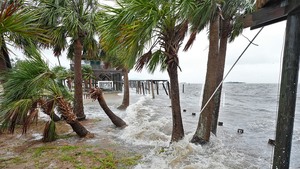Tropical Storm Milton forms in Gulf, heads toward west coast of Florida Peninsula
Milton is forecast to strengthen and bring life-threatening impacts to portions of the west coast of Florida next week.

Less than 10 days after Hurricane Helene made landfall in Florida, the state is bracing for another potentially devastating blow from a hurricane in the Gulf of Mexico.
Tropical Storm Milton formed in the western Gulf on Saturday morning just hours after it became a tropical depression, the National Hurricane Center said in a special alert. The 13th named storm, which uses the letter M, is running ahead of pace – it doesn’t usually occur until October 25.
Milton is forecast to strengthen and bring life-threatening impacts to portions of the west coast of Florida next week.
The storm is expected to “quickly intensify while it moves eastward to northeastward across the Gulf of Mexico and be at or near major hurricane strength when it reaches the west coast of the Florida Peninsula mid week,” the hurricane center said. As of Saturday afternoon, it is expected to make landfall in Florida as at least a Category 2 hurricane.
Hurricane watches, as well as storm surge watches, will likely be issued for portions of the Florida coast on Sunday – a dangerous storm surge is expected for some areas that were just affected by Helene.
“Regardless of development, locally heavy rains could occur over portions of Mexico during the next day or two, and over much of Florida late this weekend through the middle of next week,” the NHC said.
The storm threat comes after Helene made landfall September 26 on Florida’s Big Bend as a Category 4 and created a 500-mile path of destruction with catastrophic flooding, damaging winds and power outages. Local authorities have reported more than 200 deaths across six states and fear that number could rise.
Helene was one of the largest storms the Gulf of Mexico has seen in the last century.
The latest storm forecast at this point calls for widespread totals of 4 to 6 inches of rain across almost the full length of the state, from Gainesville down through Key West, with isolated higher amounts up to 10 inches possible through Thursday. Tampa has already already seen more than 20 inches of rainfall above normal for the year. Cities like Melbourne, Jacksonville, Naples and Fort Myers all have more than a foot of surplus rainfall so far this year as well.
There is also an increasing risk of storm surge for the western Florida Peninsula as early as late Tuesday or Wednesday. Damaging winds, tornadoes and waterspouts will also be possible next week.
The hurricane center is warning people in Mexico’s Yucatan Peninsula, the Florida Peninsula, the Florida Keys, as well as the Bahamas to closely monitor this system this weekend and early next week for any impacts.
Meanwhile, Hurricane Kirk remained a Category 4 major hurricane, and waves from the system were affecting the the Leeward Islands, Bermuda, and the Greater Antilles, forecasters said. The storm’s swells were expected to spread to the East Coast of the United States, the Atlantic Coast of Canada and the Bahamas on Saturday night and Sunday.
Forecasters warned the waves could cause life-threatening surf and rip current conditions.
Kirk was expected to weaken starting Saturday, the center said.
Though there were no coastal warnings or watches in effect for Kirk, the center said those in the Azores, where swells could hit Monday, should monitor the storm’s progress.
Kirk was about 975 miles (1,570 kilometers) east-northeast of the northern Leeward Islands with maximum sustained winds of 130 mph (209 kph).



